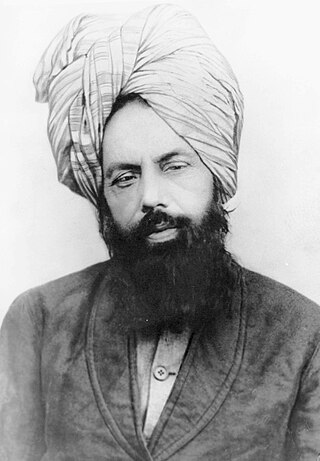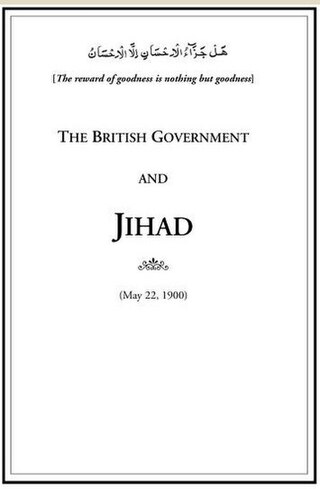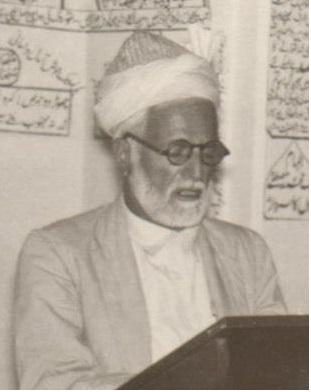Related Research Articles

MirzāGhulām Aḥmad was an Indian religious leader and the founder of the Ahmadiyya movement in Islam. He claimed to have been divinely appointed as the promised Messiah and Mahdī—which is the metaphorical second-coming of Jesus (mathīl-iʿIsā), in fulfillment of the Islamic prophecies regarding the end times, as well as the Mujaddid of the 14th Islamic century.

Ahmadiyya Islam considers Jesus (ʿĪsā) as a mortal man, entirely human, and a prophet of God born to the Virgin Mary (Maryam). Jesus is understood to have survived the crucifixion based on the account of the canonical Gospels, the Qurʾān, hadith literature, and revelations to Mirza Ghulam Ahmad. Having delivered his message to the Israelites in Judea, Jesus is understood to have emigrated eastward to escape persecution from Judea and to have further spread his message to the Lost Tribes of Israel. In Ahmadiyya Islam, Jesus is thought to have died a natural death in India. Jesus lived to old age and later died in Srinagar, Kashmir, and his tomb is presently located at the Roza Bal shrine.

The Ahmadiyya Caliphate is a non-political caliphate established on May 27, 1908 following the death of Mirza Ghulam Ahmad, the founder of the Ahmadiyya Muslim Community, who claimed to be a Prophet, a Messenger, the promised Messiah and Mahdi, the expected redeemer awaited by Muslims. It is believed by Ahmadis to be the re-establishment of the Rashidun Caliphate that commenced following the death of the Islamic prophet Muhammad. The caliphs are entitled Khalīfatul Masīh, sometimes simply referred to as Khalifa. The caliph is the elected spiritual and organizational leader of the worldwide Ahmadiyya Muslim Community and is the successor of Ghulam Ahmad. He is believed by the Community to be divinely ordained and is also referred to by its members as Amir al-Mu'minin and Imam Jama'at. The 5th and current Caliph of the Messiah of the Ahmadiyya Community is Mirza Masroor Ahmad.

Al-Barāhīn al-Ahmadīyyah 'alā Haqīqatu Kitāb Allāh al-Qur'ān wa'n-Nabūwwatu al-Muhammadīyyah is a five-part book written by Mirza Ghulam Ahmad, the founder of the Ahmadiyya Movement. The first two parts were published in 1880 CE, the third volume was published in 1882, the fourth volume in 1884 and the fifth volume in 1905. In writing the book, Ghulam Ahmad sought to rejuvenate Islam by arguing for the validity of its principles and vindicating its teachings in response to Christian and Hindu polemics against Islam as well as atheistic philosophies. In this context, a significant portion of the subject matter of the book is dedicated to the defence of Islam as a whole against the criticism of Muhammad, the Qur'an and Islam that was raised in the 18th and 19th centuries predominantly by Christian missionaries and Hindu revivalists.

Al-Masih ad-Dajjal, otherwise referred to simply as the Dajjal, is an evil figure in Islamic eschatology who will pretend to be the promised Messiah and later claim to be God, appearing before the Day of Judgment according to the Islamic eschatological narrative. The word Dajjal is not mentioned in the Quran, but he is mentioned and described in the Hadith. Corresponding to the Antichrist in Christian tradition, the Dajjal is said to emerge out in the east, although the specific location varies among the various sources. The Dajjal will imitate the miracles performed by Jesus Christ, such as healing the sick and raising the dead, the latter done with the aid of demons. He will deceive many people, such as weavers, magicians and children of fornication.

Mirza Basheer-ud-Din Mahmood Ahmad was the second caliph, leader of the worldwide Ahmadiyya Muslim Community and the eldest son of Mirza Ghulam Ahmad from his second wife, Nusrat Jahan Begum. He was elected as the second successor of Mirza Ghulam Ahmad on 14 March 1914 at the age of 25, the day after the death of his predecessor Hakim Nur-ud-Din.

Hakeem Noor-ud-Din was a close companion of Mirza Ghulam Ahmad, the founder of the Ahmadiyya Movement, and his first successor and first Ahmadiyya caliph since 27 May 1908.

Tafseer-e-Kabeer is a 10 volume Urdu exegesis of the Quran written by Mirza Bashir-ud-Din Mahmud Ahmad, the second Caliph of the Ahmadiyya Muslim Community, over a period of 20 years. It is often seen as a masterpiece by some scholars.

In Ahmadiyya theology, the view on the Prophets of God differs significantly from Mainstream Islam. The main difference centres on the Quranic term Khatam an-Nabiyyin with reference to Muhammad which is understood by Ahmadis in terms of perfection and testification of prophethood instead of chronological finality. Accordingly, Muhammad is held to be the last prophet to deliver a religious law to humanity in the form of the Quran whose teachings embody a perfected and universal message. Although, in principle, prophets can appear within Islam but they must be non-lawbearing prophets dependent upon the sharia of Muhammad. Their prophethood is reflective of that of Muhammad, that is, within his Seal; and their role is merely that of reviving and purifying the faith. They cannot be prophets in their own right and cannot change, add to or subtract from the religious law of Islam. As such, Ahmadis, regard their founder Mirza Ghulam Ahmad (1835–1908) as a subordinate prophet who appeared as the promised Messiah and Mahdi in accordance with Islam's eschatological prophecies. In contrast to mainstream Muslims who believe Jesus to be still alive and one who would return himself towards the end of time, Ahmadis believe Jesus to have died a natural death and view the coming of such an independent, Israelite prophet to amount to breaking the Seal of Prophethood.

Ahmadiyya, officially the Ahmadiyya Muslim Community or the Ahmadiyya Muslim Jama'at, is an Islamic revival or messianic movement originating in British India in the late 19th century. It was founded by Mirza Ghulam Ahmad (1835–1908), who claimed to have been divinely appointed as both the Promised Mahdi and Messiah expected by Muslims to appear towards the end times and bring about, by peaceful means, the final triumph of Islam; as well as to embody, in this capacity, the expected eschatological figure of other major religious traditions. Adherents of the Ahmadiyya—a term adopted expressly in reference to Muhammad's alternative name Aḥmad—are known as Ahmadi Muslims or simply Ahmadis.

Jalsa Salana is a formal, annual gathering of the Ahmadiyya Muslim Community. It was initiated in 1891 by Mirza Ghulam Ahmad, the founder of the community, in Qadian, India. Usually, the gathering spans three days, beginning with the flag hoisting ceremony following the Friday Sermon. Although the convention held in the UK is deemed to be the major and 'international Jalsa' attended by Ahmadis from across the world, Ahmadis in other countries hold their own national Jalsas, sometimes attended by the Khalifatul Masih.

The British Government and Jihad is a book written in 1900 by Mirza Ghulam Ahmad, the founder of the Ahmadiyya movement in Islam. An alternative title is the True Meaning of Jihad. It was published on 22 May 1900 and was translated into English in 2006, by Islam International Publications.

Jāmi’ah al-Ahmadīyyah is an International Islamic seminary and educational institute with campuses in Pakistan, United Kingdom, India, Ghana, Canada, Germany, Nigeria, Indonesia, Bangladesh, Malaysia, Tanzania, Sri Lanka, Sierra Leone, and Kenya. In addition, there are affiliated Mu'alameen centers in Pakistan and Madagascar. Founded in 1906 as a Section in Madrassa Talim ul Islam by Mirza Ghulam Ahmad of Qadian, the founder of the Ahmadiyya Muslim Community, it is the main centre of the Ahmadiyya Muslim Community for Islamic learning.

Chaudhry Fateh Muhammad Sial (1887–1960) was a companion of Mirza Ghulam Ahmad and the first Ahmadi missionary sent from India, under the leadership of Hakeem Noor-ud-Din, the first Khalifa of the Ahmadiyya movement. In 1913, Mirza Basheer-ud-Din Mahmood Ahmad asked for volunteers to serve as Ahmadi missionaries in England. Sial volunteered and travelled to England on June 22, 1913 and arrived the following month. There he served twice as a missionary. He earned an MA in Arabic from the Aligarh Muslim University.
Abū Sayyid Muḥammad Ḥusayn Baṭālvī (c.1840-1920) was an Indian Islamic scholar of the Ahl-i Hadith movement during the late 19th and early 20th-century in British India. A native of Batala in the Punjab, he became a student of Syed Nazir Husain Dehlawi and is considered one of the founders of the Ahl-i Hadith alongside Dehlawi and Siddiq Hasan Khan. Batalvi was the editor of the magazine Isha'atus Sunnah and is best known for being a major antagonist to Mirza Ghulam Ahmad, the founder of the Ahmadiyya movement.

Shams ud Din Khan (1900–1969) was a notable early Pashtun Ahmadi in the North West Frontier province of India. He remained its Provincial Ameer [Head] (1969). He was a close associate of Khalifatul Masih II and III.( Mirza Basheer-ud-Din Mahmood Ahmad and Mirza Nasir Ahmad) in his lifetime. He was a member of the Jama’at Khilafat Committee [Electoral College] and was one of the two proposers of the name of Mirza Nasir Ahmad at the time of his Election to the seat of Khilafat in November 1965. He remained a member of the Majlis Shura [Consultative Assembly] of the Ahmadiyya Muslim Community in Pakistan.

Qazi Muhammad Yousaf was a companion of Mirza Ghulam Ahmad. He was regional head Amir of North West Frontier chapter of the Ahmadiyya Community.

Akhundzada Mohammad Abdul Ghafoor Hazarvi was a Muslim theologian, jurist, and scholar of ahadith in Pakistan. He was active in the Pakistan movement, member of Council of Islamic Ideology. He was the companion of Muhammad Ali Jinnah and separatist leader Maulana Zafar Ali Khan and was active in the independence movement of Pakistan against the British Raj. He was a Sufi of the Chishti Sufi order and the founding member of the religious Barelvi Sunni strain political party Jamiat Ulema-e-Pakistan (JUP). He became its president in 1948. He was also a political figure in Pakistan and was the first recipient of Nishan-e-Imtiaz by the President of Pakistan. He was also the chairman of Majlis-e-Tahaffuz-e-Khatme Nabuwwat, an organisation opposed to the Ahmadiyya Movement that waged a campaign against Mirza Ghulam Ahmed's claim of prophethood.

The Ahmadiyya branch in Islam has relationships with a number of other religions. Ahmadiyya consider themselves to be Muslim, but are not regarded as Muslim by mainstream Islam. Mainstream Muslim branches refer to the Ahmadiyya branch by the religious slur Qadiani, and to their beliefs as Qadianism a name based on Qadian, the small town in India's Punjab region where the founder of Ahmadiyya, Mirza Ghulam Ahmad was born.

Ahmadiyya is a persecuted branch of Islam in Saudi Arabia. Although there are many foreign workers and Saudi citizens belonging to the Ahmadiyya movement in Saudi Arabia, Ahmadis are officially banned from entering the country and from performing the pilgrimage to Mecca and Medina. This has led to criticisms from multiple human rights organizations.
References
- 1 2 "Introducing the Books of the Promised Messiah (as) | Islam Ahmadiyya".
- ↑ ’’Tazkirat-ul-Mahdi’’, by Pir Siraj-ul-Haq Nomani, Zia-ul-Islam Press, Qadian, pp. 48-49.
- ↑ Al Hakam Vol. VI No. 23 June 24, 1902 p. 12.
- ↑ Noor-ul-Haq, Part I, p. 118, Roohāni-Khazāin, Volume 8, p. 158.
- ↑ "The Thousand Curses of Mirza Ghulam of Qadian". alhafeez.org.
- ↑ Noor-ul-Haq, Part I, p. 123, Roohāni Khazāin, Volume 8, p. 163.
- ↑ "Imam Mahdi and Ramadhan with two Eclipses". www.central-mosque.com.
- ↑ "Response to "Flaws in the Ahmadiyya Eclipse Theory" | Islam Ahmadiyya".